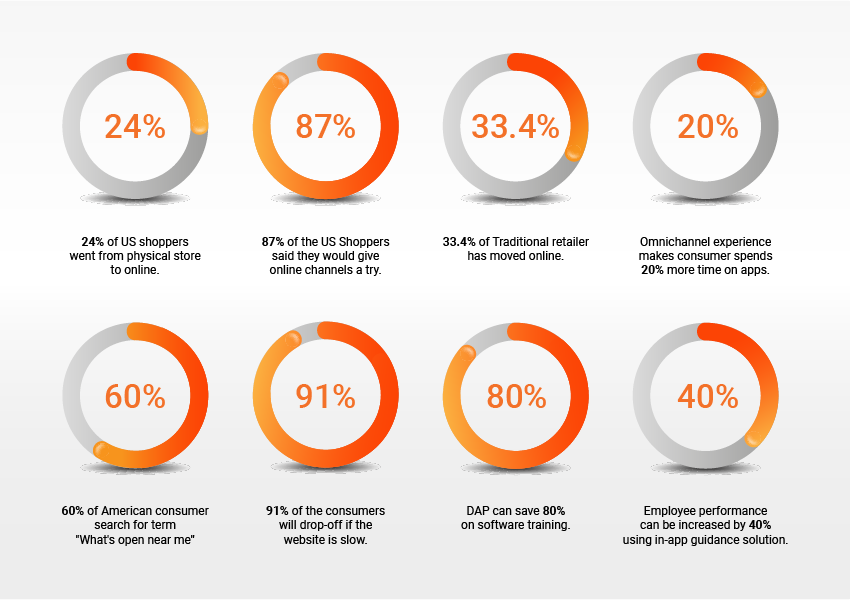Digital Transformation in Retail is the need of the hour. The pandemic has caused many businesses to suffer adversely. One of the most impacted industry is retail and especially the traditional retail businesses.
Retail demand has plummeted making many companies suffer huge financial loss. The loss is not just because people are unable to purchase due to the financial crisis but also because of lack of accessibility.
This issue can only be solved with a wave of digital transformation in retail.
Many companies have already started to march in this direction and as a result, a lot of existing retail digital transformation trends are on the rise and new trends are also emerging.
In this blog, we will discuss what is digital transformation in retail, and the latest trends associated with it.
What is Digital Transformation in Retail?
Digital Transformation in retail is about revamping the business structure in line with the latest technologies to make the life of consumers easy and boost the revenue of the organization.
The word “Digital Transformation Strategy” in retail goes beyond technology. No doubt technology is considered as the major driver but factors like business processes, business models, and other innovative ways play an equally important role in making the retail transformation effort a success.
The goal is to reach out to consumers by using digital means and to be as effective as the offline channels. The digital transformation in retail sector can increase the customer retention rate by providing them the product and services they desire in an intended manner.
To deliver what your consumer wants you must know the current trends in retail concerning Digital Transformation and since the advent of COVID-19 a lot of things have changed in the retail industry.

Benefits of digital transformation in retail
The biggest benefit of adopting digital transformation in retail sector is that it allows you to understand your clients better. This transformation gives you access to customer analytics that enables you to customize and personalize your campaigns and offerings, leading to higher conversion rates for your business.
Accelerating digital transformation in retail allows you to identify and address any inefficiencies in their processes, especially as pertains to inventory management, and customer service. With these insights, the retailer is in a better position to optimize their processes thereby reducing business costs and providing better services to customers.
Digital transformation in retail examples
One example of digital transformation in retail sector is when a business sets up a way to purchase online when they didn’t have it before. This can be adding a purchase option on a website or social media so customers can directly buy online instead of having to come into the store each time.
Going digital can enable customers to shop without a cashier. Retailers can also sell online while maintaining their physical stores. You can employ AI and automate some processes like inventory tracing, stock keeping, and locating items. The result is a convenient store that customers can even access using mobile apps.
Customer experience is an essential element of any retail store. With digital transformation, you can improve customer experience, ensuring that customers enjoy their buying journey and get high-quality products. Additionally, it increases productivity, making the business more effective, thereby staying ahead of the competition.
What are the trends of Digital Transformation in Retail?
1. Consumers are Going Internet First

The consumer behavior has changed since the 3G rollout and with the pandemic, people are in their homes trying to access products, goods, and services by going online which otherwise would be purchased in a physical store.
According to Google service, 24% of US shoppers went online to purchase goods and products which they would normally buy in-store, while 87% of the US shoppers said they would give it a try.
This proves that consumers are either already online or planning to do so.
In any case, it is wise for retail business to start creating an online presence if they already haven’t. You can enable online presence by creating a website or App using which consumers can buy your product or at least can visualize it.
2. Omnichannel Experience
According to a study conducted by Fujitsu, 33.4% of traditional retailers have moved online and now sell their products via online portals.
Most of these retailers have adopted the hybrid model wherein they have created a seamless customer experience for their consumers. The buyer would have the same experience with the brand whether they go in person or online.
You have to up your game even further as in a recent study by Google it was identified that consumers are using multiple devices at home and as a result, they spent 20% more time on Apps and websites.

So, creating an omnichannel experience is of paramount importance, and failing to do so could dent your business.
Retail businesses that had initiated their digital transformation efforts before the COVID phase have been able to sustain during the lockdown. During the peak sales days, the companies that adopted digital mediums were able to make the same levels of revenue if not more.
Consumers were already using multiple channels before buying any product and now the numbers have only gone up.
Since the business environment is changing, companies must focus on meeting consumers at any point in their customer journey and for that to happen you must create an omnichannel experience.
3. Digital and Cloud Infrastructure
Once a company goes online, the brand website becomes the primary store. With more than 284 million internet users in the US alone, the stakes are high.
The possibility of consumers purchasing your product from an online store is high and if not, then the chances of them researching your product are even higher.
People are always searching where, when, and how they can purchase the goods they desire. Nearly 60% of the US and Canadian consumers search for the term “What‘s open near me”.

So, investing in your digital and cloud infrastructure becomes important. Having a basic setup will not be helpful, you must be prepared for any adversity such as for events like Cyber Monday or Black Friday where the website traffic go significantly high and could possibly slow down the website speed, or even crash it, affecting your revenue.
In a survey conducted by Google Cloud, 4 in 5 respondents said they always try to prepare for such events by bolstering their tech infrastructure to display, manage, process, and deliver the customer’s order. The important part is the consumer’s interaction with the website and if they are unable to execute any action in an intended manner then there is a 91% chance of them dropping off and they might never return.
When the stakes are so high it is a must to invest in your digital infrastructure but unfortunately, more than 24% of the retailers are not prepared with their infrastructure.
Here you are not only losing out on the revenue but also jeopardizing the brand image of your company.
Having a proper digital and cloud infrastructure is not an option but a necessity.
Relevant read:- Learn How technology is changing business
4. The Change in Role of Employees
To enable a digitally viable environment for the consumers, companies usually invest internally to acquire new software, and applications to realize the online dream.
But with new software comes new challenges as training your employees on new software and new processes become difficult.

Spending time on traditional training methods is costly and slow. To make training effective modern retail business started using technologies like Digital Adoption Platform(DAP) that train your employees efficiently while doing their job.
They can become productive from day one as the Digital Adoption Solution(DAS) guides employees from one step to another seamlessly. It also houses all the relevant documentation, videos, and walkthrough of the software and acts as a knowledge base that sits right on top of any web-based application.
At Apty we have seen that any enterprise can jump-start their Digital Transformation efforts with the Digital Adoption Platform and can save up to 80% on software training and can increase employee performance by 40%.
The Way Ahead!
The true repercussions of COVID have yet to be fully unveiled. We are still facing the unknown. Many companies have gone out of business and went bankrupt while some organizations sustained and even fewer prospered.
Industry trends are rapidly changing and tackling that is not an easy task. But one thing is for sure – being digitally prepared is the key to sustainability.
Retail Digital Transformation is the need of the hour. Businesses must embrace this change by adopting the latest digital trends to overcome the modern challenges.
Let’s approach this challenge with an open mind and adapt to the change.













